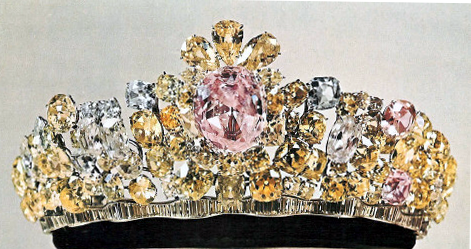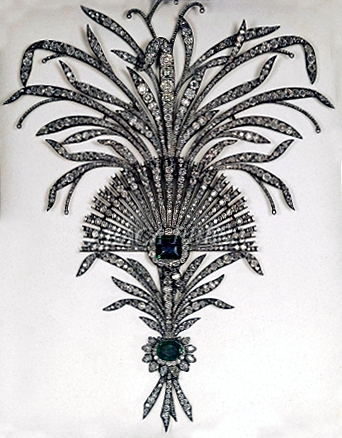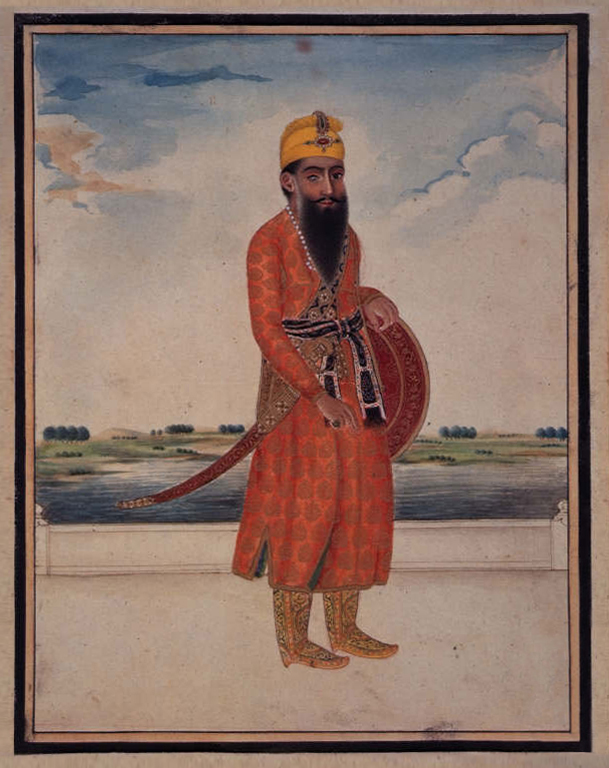|
Darya-ye Noor
The or 'Ocean of Light'), also spelled Darya-ye Noor and Daria-i-Nur, is one of the largest cut diamonds in the world, weighing an estimated 182 carats (36 g). Its colour, pale pink, is one of the rarest to be found in diamonds. The diamond is currently in the Iranian National Jewels collection of the Central Bank of Iran in Tehran. During the reign of Naser al-Din Shah, an elaborate frame was crafted from 457 smaller diamonds and four rubies, crowned by Iran's imperial insignia. However, another diamond with the same name is in a private collection in Bangladesh. Dimensions It is and weighs around 182 metric carats. It is the world's largest known pink diamond. It may have been cut originally from an even larger stone. History This diamond, as is also presumed for the Koh-i-Noor, was mined in Kollur mine in the Golcanda region of Andhra Pradesh, India. Its early origins are shrouded in mystery, but it is believed to have been one of the eyes of the Mughal Peacock Thr ... [...More Info...] [...Related Items...] OR: [Wikipedia] [Google] [Baidu] |
Iranian National Jewels
The Iranian National Jewels (, ''Javāherāt-e Melli-ye Irān''), originally the Iranian Crown Jewels (, ''Javāherāt-e Saltanati-ye Irān''), include elaborate crowns, thirty tiaras, and numerous aigrettes, a dozen bejeweled swords and shields, a number of unset precious gems, numerous plates and other dining services cast in precious metals and encrusted with gems, and several other more unusual items (such as a large golden globe with the oceans made of emeralds) collected or worn by the Iranian monarchs from the 16th century (Safavid Iran) and on. The collection is housed at the Treasury of National Jewels, situated inside the Central Bank of Iran on Tehran's Ferdowsi Street. Safavid and Afsharid conquests The majority of the items now in the collection were acquired by the Safavid dynasty, which ruled Iran from 1502 to 1736 AD. Afghans invaded Iran in 1719 and sacked the then capital of Isfahan and took the Iranian crown jewels as plunder. By 1729, however, after an inte ... [...More Info...] [...Related Items...] OR: [Wikipedia] [Google] [Baidu] |
Peacock Throne
The Peacock Throne ( Hindustani: ''Mayūrāsana'', Sanskrit: मयूरासन, Urdu: تخت طاؤس, , ''Takht-i Tāvūs'') was the imperial throne of Hindustan. The throne is named after the dancing peacocks at its rear and was the seat of the Mughal emperors of India from 1635 to 1739. It was commissioned in the early 17th century by Emperor Shah Jahan and was located in the Diwan-i-Khas (Hall of Private Audiences, or Ministers' Room) in the Red Fort of Delhi. The original throne was taken as a war trophy by Nader Shah, Shah of Iran in 1739 after his invasion of India. Its replacement disappeared during or soon after the Indian Rebellion of 1857. History Shah Jahan ruled in what is now considered the Golden Age of the vast Mughal Empire, which covered almost all of the Indian subcontinent. He ruled from the newly constructed capital of Shahjahanabad. The emperor was the focus around which everything else revolved, giving audiences and receiving petitioners. The rul ... [...More Info...] [...Related Items...] OR: [Wikipedia] [Google] [Baidu] |
John Spencer Login
Sir John Spencer Login (9 November 1809 – 18 October 1863) was a Scottish people, Scottish surgeon in British India, best remembered as the guardian of Maharajah Duleep Singh and the Koh-i-Noor diamond following the Second Anglo-Sikh War, annexation of Punjab and Treaty of Lahore#Text of the 1849 Last Treaty of Lahore, Last Treaty of Lahore. Born in the seaport of Stromness, Orkney, in 1809, Login went on to study medicine at the University of Edinburgh and was, within a few years, offered the post of assistant surgeon for the East India Company. Arriving in Kolkata, Calcutta in 1832, he initially had appointments with the Bengal Army, Bengal establishment and the Nizam of Hyderabad, Nizam's army. Later roles included, amongst others, a medical charge of the horse artillery in the First Anglo-Afghan War, Afghan campaign, residency surgeoncy at Lucknow, action in the Second Anglo-Sikh War and in 1849, the appointment as the Governor of Lahore. It was under Login and his wife's g ... [...More Info...] [...Related Items...] OR: [Wikipedia] [Google] [Baidu] |
Company Rule In India
Company rule in India (also known as the Company Raj, from Hindi , ) refers to regions of the Indian subcontinent under the control of the British East India Company (EIC). The EIC, founded in 1600, established its first trading post in India in 1612, and gradually expanded its presence in the region over the following decades. During the Seven Years' War, the East India Company began a process of rapid expansion in India, which resulted in most of the subcontinent falling under its rule by 1857, when the Indian Rebellion of 1857 broke out. After the rebellion was suppressed, the Government of India Act 1858 resulted in the EIC's territories in India being administered by the Crown instead. The India Office managed the EIC's former territories, which became known as the British Raj. The range of dates is taken to have commenced either in 1757 after the Battle of Plassey, when the Nawab of Bengal Siraj ud-Daulah was defeated and replaced with Mir Jafar, who had the support of ... [...More Info...] [...Related Items...] OR: [Wikipedia] [Google] [Baidu] |
Sikh Empire
The Sikh Empire was a regional power based in the Punjab, Punjab region of the Indian subcontinent. It existed from 1799, when Maharaja Ranjit Singh captured Lahore, to 1849, when it was defeated and conquered by the East India Company, British East India Company following the Second Anglo-Sikh War. At its peak in the mid-19th century the empire extended from Gilgit and Tibet under Qing rule, Tibet in the north to the Thar Desert, deserts of Sindh in the south and from the Khyber Pass in the west to the Sutlej in the east, and was divided into eight provinces. Religiously diverse, with an estimated population of 4.5 million in 1831 (making it the List of countries by population in 1800, 19th most populous state at the time), it was the last major region of the Indian subcontinent to be annexed by the British Raj, British Empire. In 1799, Ranjit Singh of Sukerchakia Misl captured Lahore from the Sikh triumvirate which had been ruling it Sikh period in Lahore#Sikh triumvirate ... [...More Info...] [...Related Items...] OR: [Wikipedia] [Google] [Baidu] |
Ranjit Singh
Ranjit Singh (13 November 1780 – 27 June 1839) was the founder and first maharaja of the Sikh Empire, in the northwest Indian subcontinent, ruling from 1801 until his death in 1839. Born to Maha Singh, the leader of the Sukerchakia Misl, Ranjit Singh survived smallpox in infancy but lost sight in his left eye. At the age of ten years old, he fought his first battle alongside his father. After his father died around Ranjit's early teenage years, he became leader of the Misl. Ranjit was the most prominent of the Sikh leaders who opposed Zaman Shah, the ruler of Durrani Empire, during his third invasion. After Zaman Shah's retreat in 1799, he captured Lahore from the Sikh triumvirate which had been ruling it since 1765. At the age of 21, he was formally crowned at Lahore. Before his rise, the Punjab had been fragmented into a number of warring Sikh (known as misls), Muslim and Hindu states. A large part of Punjab was under direct Durrani control. By 1813, Ranjit Sin ... [...More Info...] [...Related Items...] OR: [Wikipedia] [Google] [Baidu] |
Qajar Dynasty
The Qajar family (; 1789–1925) was an Iranian royal family founded by Mohammad Khan (), a member of the Qoyunlu clan of the Turkoman-descended Qajar tribe. The dynasty's effective rule in Iran ended in 1925 when Iran's '' Majlis'', convening as a constituent assembly on 12 December 1925, declared Reza Shah, a former brigadier-general of the Persian Cossack Brigade, as the new ''shah'' of what became known as Pahlavi Iran. List of Qajar monarchs Qajar imperial family The Qajar Imperial Family in exile is currently headed by the eldest descendant of Mohammad Ali Shah, Sultan Mohammad Ali Mirza Qajar, while the Heir Presumptive to the Qajar throne is Mohammad Hassan Mirza II, the grandson of Mohammad Hassan Mirza, Sultan Ahmad Shah's brother and heir. Mohammad Hassan Mirza died in England in 1943, having proclaimed himself shah in exile in 1930 after the death of his brother in France. Today, the descendants of the Qajars often identify themselves as such and hol ... [...More Info...] [...Related Items...] OR: [Wikipedia] [Google] [Baidu] |
Agha Mohammad Khan Qajar
Agha Mohammad Khan Qajar (; 14 March 1742 – 17 June 1797), also known by his regnal name of Agha Mohammad Shah (), was the founder of the Qajar dynasty of Iran, ruling from 1789 to 1797 as Shah. Originally a chieftain of the Quwanlu branch of the Qajar tribe, Agha Mohammad Khan was enthroned as the king of Iran in 1789 and crowned ''shāhanshāh'' (“King of Kings”) in 1796, after leading the Reunification of Iran (1779-1796). Agha Mohammad Khan Qajar was castrated as a toddler upon his capture by Adel Shah Afshar and hence was childless. He was assassinated on 17 June 1797, and was succeeded by his nephew, Fath-Ali Shah Qajar. Agha Mohammad Khan's reign is noted for the return of a centralized and unified Iran and for relocating the capital to Tehran, where it still stands today. He is noted for his cruel and rapacious behavior, particularly during his Georgia and Kerman campaigns. However, he has also been described as a "pragmatic, calculating, and shrewd military a ... [...More Info...] [...Related Items...] OR: [Wikipedia] [Google] [Baidu] |
Lotf Ali Khan
Lotf Ali Khan (; ) was the last Shah of the Iranian Zand dynasty, ruling from 1789 to 1794. Early life Lotf Ali Khan Zand came to power after a decade of infighting among a succession of violent and inept Zand chiefs following the death in 1779 of the dynasty's founder, Karim Khan Zand. Their failure to agree on a successor and to govern with the same benevolence as Karim Khan eroded public faith in the Zands. An increasing number of local and regional leaders began aligning themselves with the eunuch Agha Mohammad Khan Qajar, who sought to defeat and succeed the Zands. The son of Jafar Khan, Lotf Ali Khan claimed the throne in 1789 upon the death of his father. Jafar Khan had been poisoned by a slave bribed by a rival family member, Sayed Morad Khan Zand. On hearing of his father's murder, Lotf Ali Khan marched to the Zand capital of Shiraz. Sayed Morad Khan was forced to surrender and was executed. Reign Soon after assuming his title, Lotf Ali Khan's principal rival, A ... [...More Info...] [...Related Items...] OR: [Wikipedia] [Google] [Baidu] |
Shahrukh Afshar
Shahrokh Mirza (; 1734–1796), better known by his dynastic title of Shahrokh Shah (), was the Afsharid king (shah) of the western part of Khorasan (corresponding to the present-day Khorasan Province) from 1748 to 1796, with a two-month interruption. A grandson of the Iranian conqueror Nader Shah (), Shahrokh was the son of Reza Qoli Mirza Afshar and his Safavid wife Fatemeh Soltan Begom, who was the sister of Tahmasp II, the penultimate Safavid shah of Iran. Shahrokh's half-Safavid descent made him stand out amongst his Afsharid relatives and was used to bolster the legitimacy of his grandfather. After the assassination of Nader Shah in 1747, his nephew Ali-qoli Khan (who assumed the regnal name Adel Shah), ascended the throne in Mashhad and had all of Nader Shah's descendants in fortress of Kalat massacred. Shahrokh was spared in case his Safavid lineage would come of use and was instead kept in the fortress as a prisoner. While Adel Shah was battling his rebellious you ... [...More Info...] [...Related Items...] OR: [Wikipedia] [Google] [Baidu] |
Muhammad Shah
Mirza Nasir-ud-Din Muḥammad Shah (born Roshan Akhtar; 7 August 1702 – 26 April 1748) was the thirteenth Mughal emperor from 1719 to 1748. He was son of Khujista Akhtar, the fourth son of Bahadur Shah I. After being chosen by the Sayyid Brothers of Barha, he ascended the throne at the young age of 16, under their strict supervision. He later got rid of them with the help of Nizam-ul-Mulk, Asaf Jah I – Syed Hussain Ali Khan was murdered at Fatehpur Sikri in 1720 and Sayyid Hassan Ali Khan Barha was captured in battle in 1720 and fatally poisoned in 1722. Muhammad Shah was a great patron of the arts, including musical, cultural and administrative developments, he is thus often referred to as Muhammad Shah Rangila (). His pen-name was "Sadrang" and he is also sometimes referred to as "Bahadur Shah Rangila" after his grand father Bahadur Shah I. Muhammad Shah's reign was marked by rapid and irreversible decline of the Mughal Empire that was exacerbated by Nader Shah's ... [...More Info...] [...Related Items...] OR: [Wikipedia] [Google] [Baidu] |










